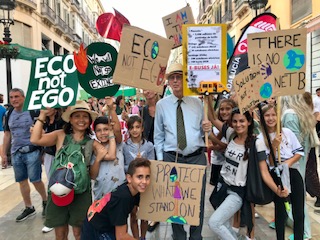Lu and I joined the children’s climate strike in Malaga yesterday.

The photo is slightly misleading in that the majority of the protesters were older, with a surprising number of Seniores. A decent if not startling turnout, and all very good-humoured.

Our information-rich poster. Translation at the end. Bus by Playmobil. Hollin is soot – the streaks are the real thing from my wood-burning fireplace. The QR code links to a paper in Nature Communications, but only one other participant took a photo of it. No media in sight.
I did quite well on photos otherwise: several dozen. Very markedly, there was disproportionate interest from middle-aged women. I assume it’s the placenta reference: it doesn’t connect in the same way to young nulliparae.
If I were Francisco de la Torre, the 77-year-old PP mayor of Malaga, would I be worried enough to reconsider my policies? For instance on slow-walking the buying of electric buses? I doubt it: we weren’t enough, nor sufficiently focused. A lot depends on whether Greta’s army, or its parents, will get down to the plank-boring work of political organization. The Occupy Wall Streeters notoriously failed to make this transition. But I might be more worried by the middle-aged women, the kind that go to meetings, who may now be circulating photos of my poster and others on their FB feeds.
Notes on the poster
Translation:
1 placenta * = 5 billion soot particles [Spanish billón is said to be 1012 (US trillion) not 109 (US billion]
Malaga: 245 diesel buses
16 electric buses [in fact 15 hybrids and one BEV]
Santiago (Chile): 200 electric buses
700 by 2020
E-buses now!
* QR code link to journal article
More notes
“You talk about focus, but the poster is not about climate change but air pollution!”
In my defence:
1. Climate change and air pollution are two crises created by the same blind-alley technology, the combustion of fossil fuels. To deal with both, we just have to stop burning coal, oil and gas. (It’s true that gas creates less air pollution than the others, but it’s still not clean.) The obstacles are such that we need to deploy both powerful arguments, either of which would be sufficient in a rational world.
2. The health damage from air pollution is open-and-shut scientifically and requires no more than common sense to understand (breathing soot and fumes is bad for you). It is also more immediate, with 4.2 million excess deaths a year worldwide, right now. My example of the sooty placentas is strong emotionally, but not exceptionally so. Your grandchildren all carry a number of different pollution loads like this.
3. The main policy targets for climate action are national or supranational. In Teresa Ribera, Spain has one of the very few environment ministers who is an expert and trustworthy climate hawk. She needs support rather than unsolicited advice. Urban public transport however is very much a regional and local responsibility. Electric buses is something Señor Alcalde de la Torre can and should do, seriously and no longer with symbolic toe-dipping. Santiago is ten times the size of Malaga, so an equivalent bus purchase would be 70 by next year. According to BNEF, the TCO over 10 years is now the same or lower, so the decision to go electric does not call for political heroism.
How credible is my headline number on placental soot?
The research (paper) was carried out by Professor Tim Nawrot et al of Hasselt University in Belgium. Hasselt is a non-industrial market and college town of 77,000 inhabitants. The sample was only 25 but the methods fancy (femtosecond laser light pulses). They published two numbers for the concentration of carbon nanoparticles, 2.09 × 104 per mm3 for mothers living on main roads and 0.95 × 104 per mm3 for those living on roads with less traffic. I took the lower one, and scaled up for a mean placental weight of 500gm and density of 1.1. The authors do not use their their numbers as estimates for anywhere else: their aim was to find a possible pathway for damage already proven epidemiologically. The generalization was just me, but since Malaga is a bustling city of 500,000 my number must be a gross underestimate.
It would be quite easy to extend the study to improve it. Fresh placentas are available everywhere is great numbers, and consent is a doddle. Proud new fathers do not take photos of their offspring’s discarded life support module before it goes in the medical waste bin. But it’s doubtfully worth it, beyond one or two studies for replication. What use is an atlas of placental nanoparticle contamination? The number in any town anywhere is far too high whatever, and you can measure the pollutants directly in the air.
What would be more interesting is proof that the particles reach non-disposable parts of the baby like the heart, lungs, liver, and brain. This is highly probable, but for obvious reasons the investigation is ethically very problematic. You can’t carry out intrusive biopsies on healthy newborns without strong medical justification. The few cases where doctors need to do this anyway are atypical. The same goes for stillborns.